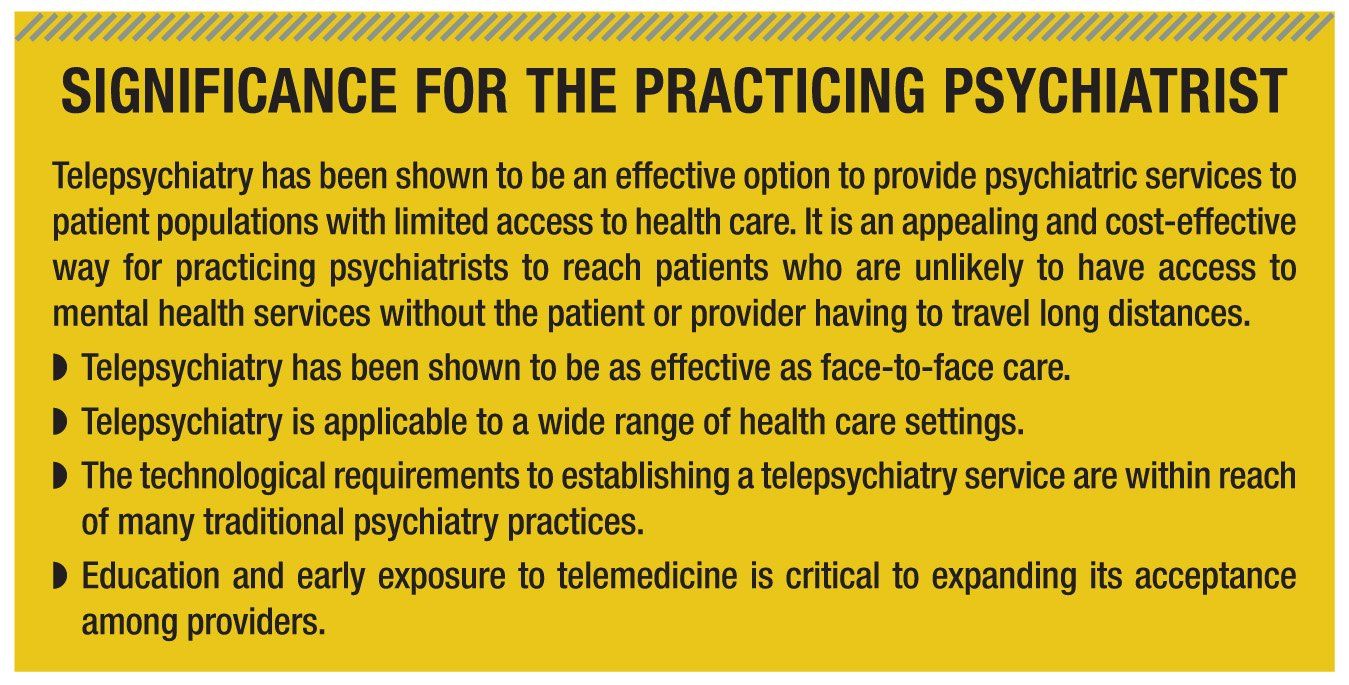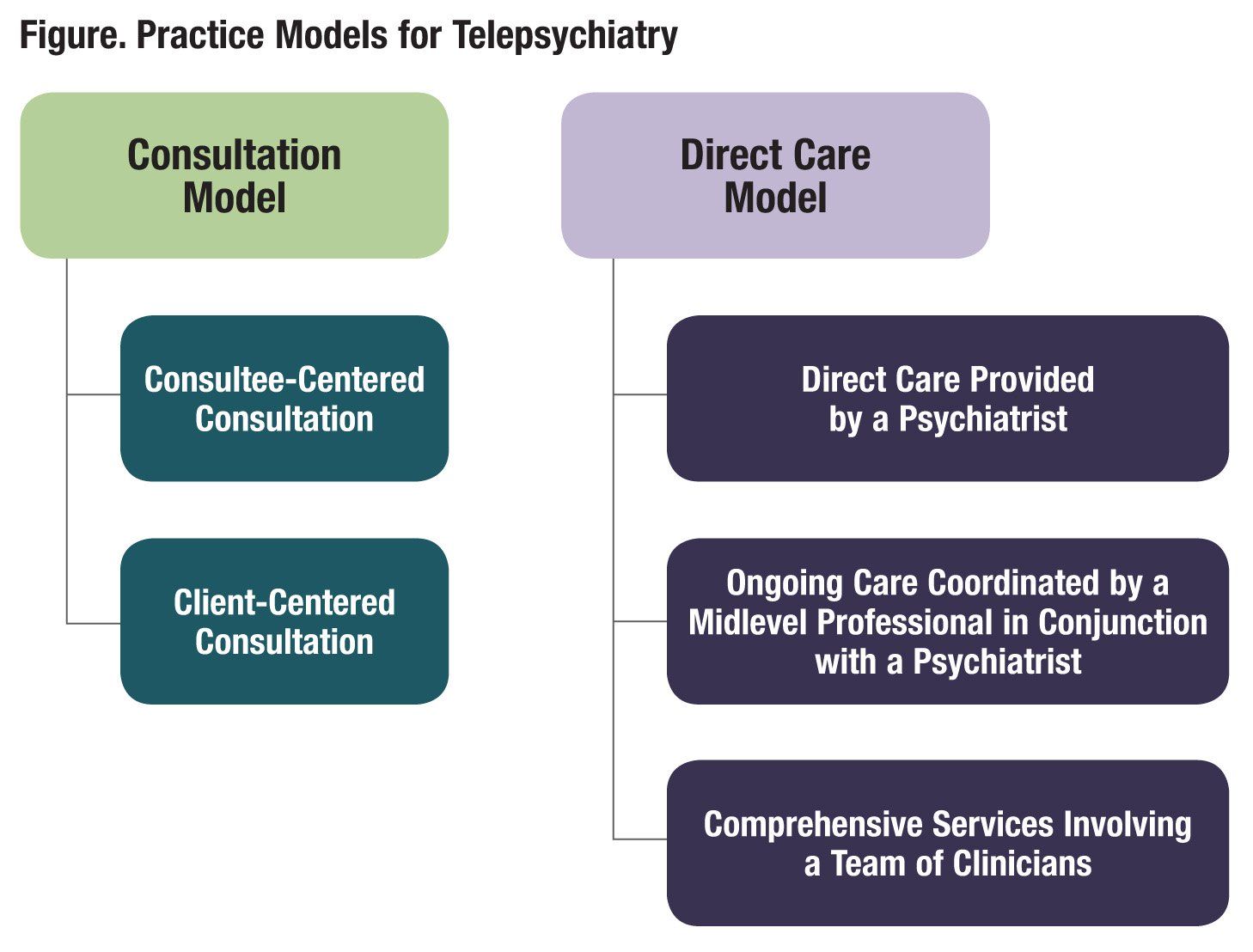Publication
Article
Psychiatric Times
Using Telehealth to Enhance Access to Evidence-Based Care
Author(s):
Findings suggest that telemental health is not only effective for diagnosis and assessment across many populations and disorders in many settings, but it appears to be comparable to face-to-face care.
SIGNIFICANCE FOR THE PRACTICING PSYCHIATRIST

Telepsychiatry has its roots in Europe. In the 1920s and into the 1940s radio consultations were performed between European countries and sailors onboard ships or people on isolated islands who were ill. In the 1950s, radiology images were being transmitted.1 In 1959, the Nebraska Psychiatric Institute was using early videoconferencing to provide group therapy, long-term therapy, and consultation-liaison psychiatry.2 By the 1980s, telepsychiatry was increasingly common.
The New Freedom Commission on Mental Health emphasized the need for prevention and treatment of mental illness so that patients with mental health conditions can receive the care they need and become functional participants in the community.3 The Commission discussed videoconferencing and telehealth as a means of access to care. In 2015, approximately 60 million people in the US were living in rural areas.4 The popularization of telemedicine has been secondary to a direct need to serve these areas.
Benefits and effectiveness of telepsychiatry
The use of telepsychiatry to provide mental health services has the potential to solve the provider shortage problem that directly affects access to care. Telepsychiatry is not only effective and well accepted; it can also increase administrative efficiency while providing positive outcomes in most clinical settings. Hilty and colleagues5 reviewed the published literature on effectiveness of telemental health compared to services provided face-to-face. Their findings suggest that telemental health is not only effective for diagnosis and assessment across many populations and disorders in many settings, but it appears to be comparable to face-to-face care. Telepsychiatry has also been found to be effective in providing access to care for inmates and veteran populations.6,7
In a study that compared telepsychiatry with standard care, participants who received treatment via telepsychiatry had greater response and remission rates.8 Positive results were also seen in a study undertaken in a skilled nursing facility.9 The findings indicate that telepsychiatry provided efficient access to care compared with regular visits by a provider who would need to travel to the nursing home multiple times. A study by De Las Cuevas and colleagues10 also demonstrated the effectiveness of telepsychiatry and how it is equivalent to in-person evaluation. In a literature review of child and adolescent psychiatry articles, Diamond and Bloch11 found telepsychiatry to be equivalent to in-person consultations and no negative outcomes were reported. As evidence continues to emerge in support of telepsychiatry as a means to reach underserved patients, we hope to see it continue to evolve into a widely available method for delivering mental health services.
Despite empirical evidence for the effectiveness of telepsychiatry when compared with in-person care many psychiatrists are still not at ease with telepsychiatry. Including telepsychiatry in residency training curriculum can help increase the number of psychiatrists who will likely use it in caring for patients.
A recent review of the use of tele-psychiatry in graduate medical education concluded that there was a need for a more evidence-based approach to telepsychiatry training and that such a training, if done right, could not only improve clinical outcomes but also promote social accountability, cultural competence, and interprofessional care.12 There appears to be a clear practice gap in the US between resident/fellow interest in telepsychiatry and the didactic curriculum and clinical experiences offered in residency programs. Pedagogical approaches have been proposed that are likely to promote these competencies including an elective that is likely to advance residents’ competence to practice telepsychiatry.13
In addition to the direct benefits of telepsychiatry for patients and providers, other benefits have also been identified, including reducing geographic and socioeconomic health disparities; better consumer compliance, education of mental health professionals, coordination of care across mental health systems; improving in recruiting and retaining mental health professionals to work in underserved or rural areas; and possible reduction of stigma associated with receiving mental health services.14
Telepsychiatry applications
Applications of telepsychiatry include both clinical and non-clinical uses such as education as well as administrative and research applications. Clinical outcomes of telepsychiatry interventions are comparable to face-to-face treatment delivered across diverse patient populations and diagnostic groups. For clinical applications, telepsychiatry can be used for both diagnostic and therapeutic applications across the life span. Common applications include diagnostic assessments, pre-hospitalization assessment and post-hospital follow-up care, medication management, psychotherapy, and consultation.
Telepsychiatry consultations can be used for routine as well as for crisis behavioral health cases. It can also be used in the development of clinical care plans, case management, psychological testing, forensic evaluations, and liaison services with other medical specialties. Points of delivery can include hospitals and their emergency departments, clinics, offices, homes, assisted living facilities, nursing homes, schools, and forensic settings. Professional users can include psychiatrists, resident physicians, nurses, social workers, psychologists, and other mental health providers. Practice models can vary from direct clinical service to consultation, as depicted in the Figure.
Telepsychiatry can be effectively used for any number of psychiatric interventions. A review of telepsychiatry for suicide prevention found no difference between use of DBT via teleconferencing versus treatment as usual.15 Telepsychiatry has also been used for cognitive assessments of patients with dementia, and it has been effective in providing care to geriatric patients in rural nursing home facilities.9,16
Figure. Practice Models for Telepsychiatry

The department of Veterans affairs has conducted studies on the use of videoconferencing to provide CBT to veterans with PTSD.17 Videoconferencing did not affect compliance with CBT treatments. Study data also show that videoconferencing was a practical way to deliver care to veterans in remote areas without affecting the quality of care provided.
Greene and colleagues18 examined the use of videoconferencing for anger management group therapy. Although the participants displayed decreased alliance towards the group leader, videoconferencing was deemed a practical and effective way of delivering care. Steel, Cox, and Garry19 looked at videoconferencing for the management of long-term conditions. Their data indicate that videoconferencing delivered similar outcomes to in-person care and was a practical way to provide care to rural communities.
Technology basics
Two-way audio-video communication in real time-videoconferencing-has become synonymous with telepsychiatry. A provider at a distant location evaluates and treats a patient at a local clinical site via live and interactive audiovisual conferencing systems. Historically telepsychiatry applications have used point-to-point network connections; with the rapid diffusion of Internet and Ethernet networks, Internet Protocol (IP) has largely replaced these older point-to-point networks.
Typically, a telepsychiatry setup includes a video camera, microphone, speakers (or headset), and one or two displays at each end of the system. Often, separate displays or a picture-in-picture (if one display) are used to enable participants to see both outgoing and incoming video. A pan-zoom-tilt control of the video camera is preferred that allows the clinician to control his or her view of the patient’s site or locally control the view that is being transmitted to the patient.
When setting up a telepsychiatry service the following security measures need to be considered and addressed:
1 Personal computer or mobile device should have the latest security patches and updates applied to the operating system and any third-party applications being utilized for tele-psychiatry encounters.
2 Audio and video transmission should be secured by using point-to-point encryption that meets recognized standards. Unauthorized persons should not be allowed access to sensitive information stored on the device or use the device to access sensitive applications or network resources.
3 Protected health information and other confidential data must be backed up to or stored on secure data storage locations.
4 When using mobile devices, special attention needs to be given to: adequate restriction on access to any patient contact information stored on the device; a passphrase or equivalent security feature before the device can be accessed, preferably using multi-factor authentication; an inactivity timeout function that requires a passphrase or re-authentication to access the device after the timeout threshold has been exceeded (the American Telemedicine Association [ATA] recommends this timeout not to exceed 15 minutes); capability to remotely disable or wipe the device in the event it is lost or stolen.
5 ATA guidelines recommend providing services at a bandwidth of 384 Kbps or higher in each of the downlink and uplink directions and providing a minimum of 640 × 360 resolution at 30 frames per second.
6 Videoconference software should not allow multiple concurrent sessions to be opened by a single user.
The American Psychiatric Association (APA) has released a telepsychiatry toolkit as a resource for its members who want to learn about the various aspects of telepsychiatry. The toolkit covers topics from history, training, practice/clinical, reimbursement, and legal issues; it is available at https://www.psychiatry.org/psychiatrists/practice/telepsychiatry. ATA practice guidelines are available at https://www.integration.samhsa.gov/operations-administration/practice-guidelines-for-video-based-online-mental-health-services_ATA_5_29_13.pdf.
Potential barriers to the widespread use of telepsychiatry
Deslich and colleagues20 have summarized the benefits and constraints of using telepsychiatry within the current system of healthcare and have identified reimbursement, licensure, privacy, security, patient safety, and interoperability as challenges.
Reimbursement. A “fee-for-service” approach is used by Medicare for payment that reimburses the clinician providing the telepsychiatry service. Reimbursement is typically provided for a diagnostic interview, pharmacologic management, and individual psychotherapy provided by psychiatrists and clinical psychologists. Services provided by other mental health providers vary by the state and may not be covered.
Infrastructure. The costs associated with development of the infrastructure and maintenance are typically non-reimbursable. In limited situations, reimbursement might be obtained from individual contracts, managed care, third-party payers, and Medicaid and Medicare. A structure for reimbursement of collateral charges (eg, technician, line time) is needed. Funds from the Federal Communications Commission’s Universal Service Fund subsidies can reduce the cost of telepsychiatry network connections. Individual states have also developed various funding streams to support telemedicine.
Licensure. For a physician to conduct a telemedicine consultation with a facility in another state, that physician must be licensed by both states’ licensing boards. Likewise, nurses and other allied health professionals have similar state licensing constraints.
Credentialing. A provider must be credentialed in the services that he or she provides, which in many cases necessitates credentialing in multiple systems. This significantly increases the burden on providers for completing applications, waiting for the review process to complete before services can start, and paying associated dues.
Impact on workplace behavior. Changes in a workplace requires restructuring the flow of daily work. If the goal of the organization is to promote the use of telepsychiatry, telepsychiatry must be integrated into the current process of patient care. Successful implementation requires that both clinicians and patients recognize that this approach to treatment is likely to improve outcomes by increasing access to care.
Privacy, security and HIPAA. Privacy considerations that are unique to telepsychiatry include the potential for non-clinical personnel to view telepsychiatry transactions and the off-camera presence of other clinical personnel. The increased use of IP videoconferencing over public networks also creates the potential for unauthorized access to protected health information. Technological solutions, such as in-codec encryption and virtual private networks, need to be implemented to address these issues, which necessitate training on secure storage and retrieval of data; medico-legal; and ethical issues related to maintaining patient privacy.
Prescribing. The Ryan Haight Online Pharmacy Consumer Protection Act of 2008, requires any practitioner issuing a prescription for a controlled substance to conduct an in-person medical evaluation at least once every 24 months.
Liability. Some malpractice providers cover telepsychiatry as part of their standard coverage while others may require additional coverage for providing telepsychiatry services.
Conclusion
The potential for telepsychiatry to improve access to mental health care is evident. The current technology is adequate for most uses and continued advances are in progress. There are numerous applications already defined and more are ripe for exploration. Barriers to implementation are primarily of the human variety and will require a combination of consumer, provider, and governmental advocacy to overcome. Given the challenges associated with disparity in access to psychiatric care, telepsychiatry can help provide access to mental health care to everyone who needs it.
Disclosures:
Dr Saeed is Professor and Chairman, Dr Pastis is Clinical Assistant Professor, Department of Psychiatry and Behavioral Medicine, Brody School of Medicine, East Carolina University, Greenville, NC.
References:
1. Ryu S. History of telemedicine: evolution, context, and transformation. Healthcare Inform Res. 2010;16:65-66.
2. American Psychiatric Association. What is Telepsychiatry? January 2017. https://www.psychiatry.org/patients-families/what-is-telepsychiatry. Accessed April 13, 2018.
3. New Freedom Commission on Mental Health. Achieving the Promise: Transforming Mental Health Care in America. Final report; 2003. Rockville, MD. DHHS Pub. No. SMA-03-3832.
4. US Census Bureau. New Census Data Show Differences Between Urban and Rural Populations; 2016. https://www.census.gov/newsroom/press-releases/2016/cb16-210.html. Accessed April 13, 2018.
5. Hilty DM, Ferrer DC, Parish MB, et al. The effectiveness of telemental health: a 2013 review. Telemed J E Health. 2013;19:444-454.
6. Brodey BB, Claypoole KH, Brodey IS, et al. Satisfaction of forensic psychiatric patients with remote telepsychiatric evaluations. Psychiat Serv. 2016;51:1305-1307.
7. Dunn BE, Choi H, Almagro UA, et al. Telepathology networking in VISN-12 of the Veterans Health Administration. Telemed J E-Health. 2000;6:349-354.
8. Yeung A, Martinson MA, Baer L, et al. The effectiveness of telepsychiatry-based culturally sensitive collaborative treatment for depressed Chinese American immigrants: a randomized controlled trial. J Clin Psychiatry. 2016;77:e996-e1002.
9. Johnston D, Jones III BN. Telepsychiatry consultations to a rural nursing facility: a 2-year experience. J Geriat Psychiatry Neurol. 2001;14:72-75.
10. De Las Cuevas C, Arredondo MT, Cabrera MF, et al. Randomized clinical trial of telepsychiatry through videoconference versus face-to-face conventional psychiatric treatment. Telemed e-Health. 2006;12:341-350.
11. Diamond JM, Bloch RM. Telepsychiatry assessments of child or adolescent behavior disorders: a review of evidence and issues. Telemed e-Health. 2010;16:712-716.
12. Sunderji N, Crawford A, Jovanovic M. Telepsychiatry in graduate medical education: a narrative review. Acad Psychiatry. 2015;39:55-62.
13. Saeed SA, Johnson TL, Bagga M, Glass O. Training residents in the use of telepsychiatry: Review of the literature and a proposed elective. Psychiat Quar. 2017;88:271-283.
14. Farrell SP, McKinnon CFR. Technology and rural mental health. Arch Psychiat Nurs. 2003;17:20-26.
15. Marasinghe RB, Kavanagh D, Edirippulige S, et al. Telehealth approaches to suicide prevention: a review of evidences. https://goo.gl/osqkDJ. Accessed April 13, 2018.
16. Loh PK, Ramesh P, Mahe, S, et al. Can patients with dementia be assessed at a distance? The use of Telehealth and standardised assessments. Intern Med J. 2004;34:239-242.
17. Morland LA, Greene CJ, Grubbs K, et al. Therapist adherence to manualized cognitive behavioral therapy for anger management delivered to veterans with PTSD via videoconferencing. J Clin Psychol. 2011;67:629-638.
18. Greene CJ, Morland LA, Macdonald A, et al. How does tele-mental health affect group therapy process? Secondary analysis of a noninferiority trial. J Consult Clin Psychol. 2010;78:746.
19. Steel K, Cox D, Garry H. Therapeutic videoconferencing interventions for the treatment of long-term conditions. J Telemed Telecare. 2011;17:109-117.
20. Deslich S, Stec B, Tomblin S, Coustasse A. Telepsychiatry in the 21st century: transforming healthcare with technology. https://www.ncbi.nlm.nih.gov/pmc/articles/PMC3709879/. Accessed April 1, 2018.







